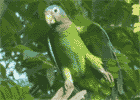|
Character of the Month: One Man's Pole . . . Is Another Bird's Perch March & April 2015 On March 3rd, our yardie pair of Jamaican Todies (aka Robin Redbreast) announced that they would like to be the Characters of the Month. For the past several years, each spring, this pair – I’m assuming it’s the same two individuals every year because one is wearing an aluminum leg band which I placed on it some time in the past – has used the side of the stone-and-concrete staircase for nesting. The concrete which fills the gaps between the stones is in rather poor condition, so the todies had a pretty easy time excavating a little tunnel for a nest a few years back. |
 Jamaican Tody (Todus todus) |
Jamaican Tody starring in Cockpit Country Is Our Home |
Normally, todies would find a nice little embankment or small cliff-face and, using their little feet, they’ll kick-out the loose dirt until they excavate a long, narrow tunnel up-to about 30 cm long. They’ll then make a 900 turn, for the final construction of a little chamber in which to lay their eggs and rear their chicks. |
When the yardie pair spent the first two weeks of March flitting around the verandah and perching on the scaffolding by the stairs, I thought
“fantastic, another exciting breeding season for our todies and I’ll be able to write all kinds of fun factoids. Things like:
Alas, for reasons known only to them, the todies didn’t think the stairs were quite up to scratch this year and they settled-in at the perimeter stone wall near the outbuilding. Annoyingly (for me. . . ), they excavated a tunnel on the west, forest-facing side of the wall, not the side which faces into the yard. So, I have to listen to their constant ratchety-rattling calls during breakfast and when I'm sitting at my computer trying to compose Character-of-the-Month stories. But I don't actually get to see the little blighters. Oh well, I can’t criticize their wanting a little privacy.
So, with that rather long preamble, and being let down by my yardie friends, I’d like to introduce the new-and-improved March & April Character of the Month: Mr. Mike’s Scaffolding
Don’t scoff – it ticks all the boxes:
| (a) It’s been in-place for s o o o o long that by now it must meet the National Heritage Trust’s criteria for an Historic Monument. |
| (b) It enables Mr. Mike to access the roof to install and check on our solar panels, which in turn keep my computer, office fan, and our wine-cooling refrigerator running (keeping Susan happy is a good box to tick). |
| (c) It might just qualify as a Key Biodiversity Area (KBA), supporting endemic, native, and migratory wildlife. |

|
The species list for the scaffolding is impressive and includes:
1. Jamaican Tody (endemic): critical perching habitat during the nesting season
2. Sad Flycatcher (Myiarchus barbirostris; aka Little Tom Fool; endemic): when supplemented with a wooden platform, the scaffolding was used for 4 consecutive years as critical nesting habitat. Alas, the wooden platform / nest box was removed last year when we re-limed the house, so the Sad Flycatchers had to shift their nest to a ridge-cap of the roof, the extended bit resembling a 'duppy perch'. But they still use the scaffolding as a favourite hunting perch, esp. to steal insects trapped in . . .
3. Golden Silk Spider (Nephila clavipes) webs, which are attached to the scaffolding. The spider webs have intercepted . . .
 Blue Kite |
5. Jamaican Mango hummingbirds (Anthracothorax mango; endemic), which steal the smallest diptera flies caught in the spider webs.
6. Black-throated Blue Warbler (Setophaga caerulescens; migrant): this species breeds in North America and over-winters almost exclusively in the insular Caribbean.
It, too, steals insects caught in the
Golden Silk Spiders’ webs. Interestingly, for the first time, in 2015, I watched a Black-throated Blue Warbler also
use the scaffolding from which to do “aerial sallying” hunting behaviour in the open yard
-- just like a Sad
Flycatcher. Normally, I see this species gleaning for insects amongst leafy vegetation.
 Yellow-faced Grassquit |
8. Yellow-faced Grassquit (Tiaris olivacea), Black-faced Grassquit (Tiaris bicolor), and Bananaquit (Coereba flaveola): all native, all like to perch on the scaffolding (and the car parked beside it) and give mating-attracting calls during the breeding season. Fledglings also like to perch on the scaffolding and beg merciless for food from their parents.
9. Northern Potoo (Nyctibius jamaicensis; native): used the scaffolding once as a dusk hunting-perch . . . but then heard that Justin Proctor was going to visit, so the bird disappeared. Fortunately for Justin, his karma is better when it comes to working with Golden Swallows in the Dominican Republic!
 Male Anolis avoiding the spider web |
11. Jamaican Boa (Epicrates [Chilabothrus] inornatus; endemic): I suspect some readers might not want to learn this, but since I don’t take sides and I like, respect, and appreciate all wild animals regardless of their ecological role – the boa also uses the scaffolding for hunting nestling birds at night. In this case, the culprit was a yardie boa named "Elvis" (Link opens to new page with a 1-minute video).
12. Endemic Pleurodonte (toothed-) snails enjoy rasping a midnight snack of fungi from the scaffolding.
 Tillandsia epiphyte |
So, for all of you who scoffed at Mr. Mike's Scaffolding, I think you now have to agree that it is pretty darn impressive with its complete ecosystem, from lowly fungi to top predators!
| All of which leads us to the motto of Windsor House: It’s not junk, it’s all structural diversity for wildlife! |
New Update: 4th May 2015:
As of 8:35 a.m., I get to add another endemic bird to the scaffolding list!
14. Rufous-tailed Flycatcher (Myiarchus validus; aka Big Head Bob; endemic):
perched very briefly on the scaffolding, with attention focused towards the ground. Although Big Head Bob -- the
local name greatly amuses me -- is common here in Windsor, we don't see them terribly often in the wide-open yard; they like
the slightly-more cluttery edge of the forest.
| PREVIOUS CHARACTER | NEXT CHARACTER |

